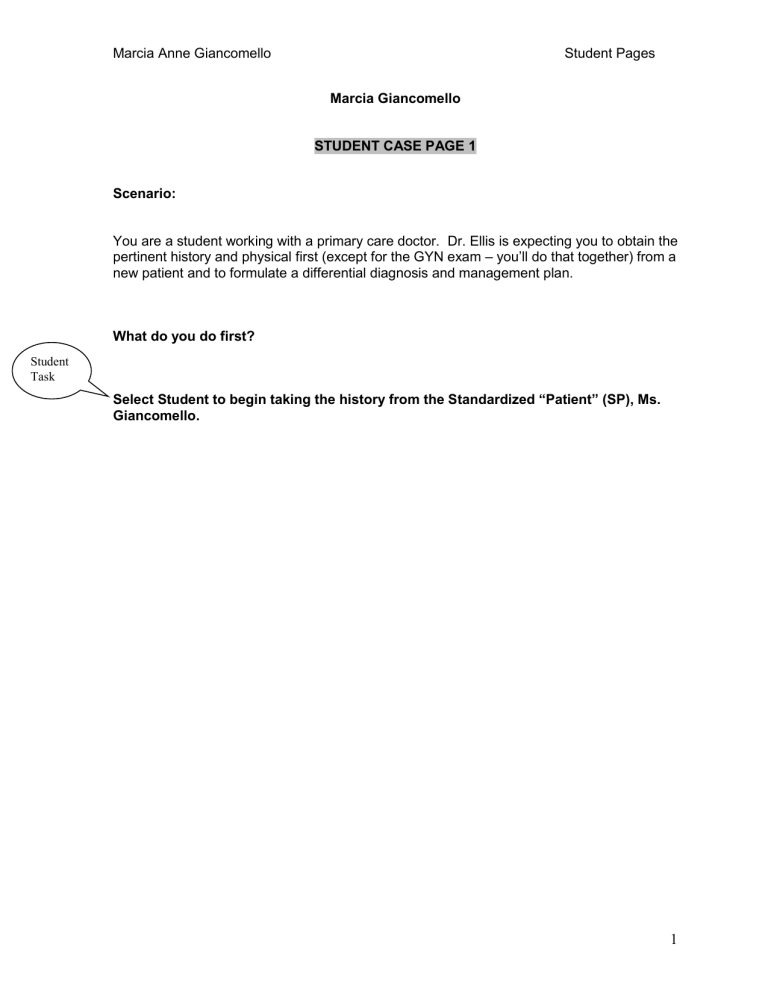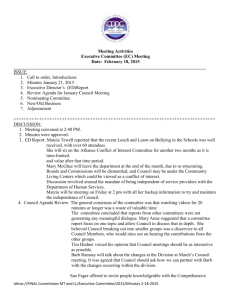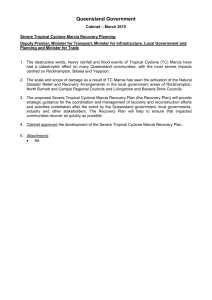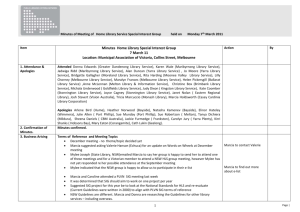Marcia Giancomello Student Pages

Student
Task
Marcia Anne Giancomello Student Pages
Marcia Giancomello
STUDENT CASE PAGE 1
Scenario:
You are a student working with a primary care doctor. Dr. Ellis is expecting you to obtain the pertinent history and physical first (except for the GYN exam – you’ll do that together) from a new patient and to formulate a differential diagnosis and management plan.
What do you do first?
Select Student to begin taking the history from the Standardized “Patient” (SP), Ms.
Giancomello.
1
Marcia Anne Giancomello Student Pages
STUDENT CASE PAGE 2
Now that you have taken the pertinent history, what problems have you identified with this patient?
What are the hypotheses/ differential diagnoses for the problems that you have identified?
Prioritize the hypotheses based on what problems you know so far.
What parts of the physical exam do you want to do and why?
2
Marcia Anne Giancomello Student Pages
STUDENT CASE PAGE 3
Vitals: Height 5’10”, Weight 125 lbs, Temp 99.6, BP 110/70, Pulse 94, RR 16
General appearance: Well developed and thin young woman in moderate distress and discomfort
Heart:
Lungs:
Regular rate and rhythm without murmurs, rubs or gallops
Clear to auscultation
Abdomen: Normoactive bowel sounds x 4 quadrants, tenderness in the left lower quadrant and suprapubic area with guarding, no rebound tenderness, no masses palpable
Skin: No rashes present
Mental-Status: Orientated x 3, memory intact, slightly anxious mood/affect
Neuro: Deep tendon reflexes 2/4 B/L, muscle strength +5 all extremities, cranial nerves intact
What problems did you identify during her physical?
3
Marcia Anne Giancomello Student Pages
STUDENT CASE PAGE 4
You go present your findings to Dr. Ellis and then go back in to perform the Genitourinary
(GU) exam together.
GU: Vaginal vault with yellowish white discharge present, + yellowish cervical discharge, cervix appears normal, negative Chadwick’s sign, + cervical motion tenderness. No distinct right lower quadrant tenderness. No masses palpable in the adnexa. No tenderness elicited during recto-vaginal exam.
Rectal exam negative for masses, tenderness, or blood.
Who should be in the room during the physical exam? Why is this important?
What are your Differential Diagnoses (hypotheses) now? Go through your previous list, and rule in or rule out based on the physical findings.
What lab tests or other diagnostic studies would you like to order? (You must give justification for each test.)
END OF SESSION 1
4
Student
Task
Marcia Anne Giancomello Student Pages
Marcia Giancomello - Session 2
STUDENT CASE PAGE 5
Based on the physical exam findings, Dr. Ellis suspects pelvic inflammatory disease.
She discusses with you the empiric treatment option:
Ceftriaxone 250 mg IM + Doxycycline 100mg orally BID x 14 days
Given the fact that Marcia is “deathly afraid” of needles, do you think Marcia will agree to this treatment plan? Are there any alternative treatments you could offer to
Marcia?
.
What else do you need to educate the patient about?
Select Student to tell the patient her diagnosis and provide education about her treatment regimen. Advise her that your office nurse will call in two days to check on how she is feeling and give her the lab test results. Ask her to come back in 2 weeks.
5
Student
Task
Marcia Anne Giancomello Student Pages
STUDENT CASE PAGE 6
Marcia returns to the office 4 months later, having not shown up for her previous follow-up.
Reviewing her chart, you see that her previous blood work came back with:
An elevated white blood cell count of 22 T/ul with a left shift of 76% neutrophils.
Endocervical mucous was positive for Chlamydia by antigen.
ESR(Sedimentation Rate) was elevated at 42
UHCG (Urine human chorionic gonadotropin or Urine pregnancy test) was negative
Patient was notified of results by nurse 3 days after the last visit and the patient told the nurse that she was feeling better at that time.
Select Student to go in and take the SP history for today.
6
Student
Task
Marcia Anne Giancomello Student Pages
STUDENT CASE PAGE 7
You present your history to Dr. Ellis and go in with her to examine the patient.
Vitals: Ht: 5’10”, Wt: 120 lbs., Temp: 101.6, Pulse: 116, RR: 16
Patient appears thin and in moderate distress and has been crying.
Heart:
Lungs:
Tachycardic, regular rhythm, no murmurs
Clear to auscultation
Abdomen: Normoactive bowel sounds x 4 quadrants, tenderness diffusely in the lower
GU: quadrants and suprapubic area with guarding, no rebound tenderness. Bruise on the right lower quadrant of the abdomen measuring about 4 inches by 3 inches. (When asked about it, she says that she bumped into the corner of her dresser.)
(+) cervical mucous and (+) cervical motion tenderness (more this time than last) – patient jumps when you do the bimanual examination. No adnexal masses palpable.
What do you think is going on with the patient?
Is your treatment choice different this time?
What ar e some reasons that a patient might not be compliant with a doctor’s suggestions?
Select Student to tell the patient what your treatment plan is and have her return to the clinic in one week.
7
Student
Task
Marcia Anne Giancomello
STUDENT CASE PAGE 8
Patient returns one week later. Dr. Ellis sends you in to get a history.
Select student to obtain a focused history.
How do you respond to the patient?
Student Pages
8
Marcia Anne Giancomello Student Pages
STUDENT CASE PAGE 9
You present the history to Dr. Ellis and you go back in together to see the patient.
Vitals: Ht: 5’10”, Wt: 115 lbs., Temp: 98.6, Pulse: 88, RR: 16
Pupils equal round and reactive to light
Left eye upper and lower lids swollen with ecchymosis
Fundus normal, no hyphema (blood in the front area of the eye)
Vision 20/20 for distant and near vision
Extraocular movements intact bilaterally, no step-up lesion of the orbit
No crepitus or deformity of the zygomatic bones bilaterally
Tympanic membranes intact bilaterally , No Battle’s sign
Left wrist is swollen and tender with decreased range of motion, but no point tenderness
Ecchymosis of the left hip
Abdomen is soft and non-tender with no guarding.
Discuss each question one at a time…
Did you give her good advice last time?
How do you feel about what happened to her?
What is the differential diagnosis for her injuries?
What do you do now?
What will you recommend for the patient?
9
Student
Task
Marcia Anne Giancomello Student Pages
STUDENT CASE PAGE 10
Select Student to talk to the patient about your recommendations.
What if her partner was a patient of yours? How would you deal with him?
END OF CASE
10





